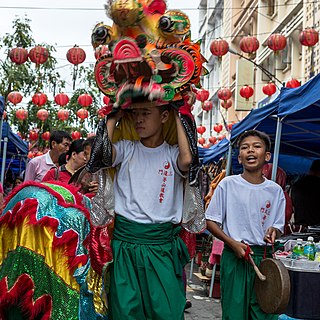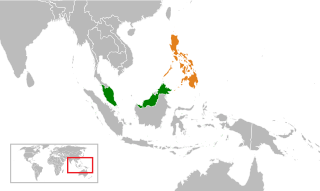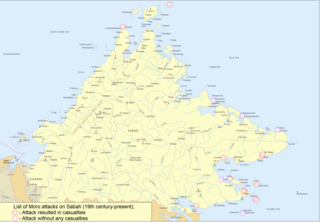
Abu Sayyaf, officially known by the Islamic State as the Islamic State – East Asia Province, was a Jihadist militant and pirate group that followed the Wahhabi doctrine of Sunni Islam. It was based in and around Jolo and Basilan islands in the southwestern part of the Philippines, where for more than five decades, Moro groups had been engaged in an insurgency seeking to make Moro Province independent. The group was considered violent and was responsible for the Philippines' worst terrorist attack, the bombing of MV Superferry 14 in 2004, which killed 116 people. The name of the group was derived from Arabic abu, and sayyaf. As of April 2023, the group was estimated to have about 20 members, down from 1,250 in 2000. They used mostly improvised explosive devices, mortars and automatic rifles.

Overseas Chinese refers to people of Chinese birth or ethnicity who reside outside Mainland China, Taiwan, Hong Kong and Macau. As of 2011, there were over 40.3 million overseas Chinese.

The Hakka, sometimes also referred to as Hakka Han, or Hakka Chinese, or Hakkas, are a Han Chinese subgroup whose ancestral homes are chiefly in the Hakka-speaking provincial areas of Guangdong, Fujian, Jiangxi, Guangxi, Sichuan, Hunan, Zhejiang, Hainan, and Guizhou in China, as well as in Taoyuan City, Hsinchu County, Miaoli County, Pingtung County, and Kaohsiung City in Taiwan. Unlike other Han Chinese subgroups, the Hakkas are not named after a geographical region, e.g. a province, county or city, in China. That is because their origins were of northern Chinese refugees fleeing social unrest, upheaval and invasions throughout the northern parts of China throughout history who then sought sanctuary in the south where the Cantonese-speaking provinces such as Guangdong and Guangxi are. The Chinese characters for Hakka literally mean "guest families". The word is Cantonese in origin and as the name implies, they are the guest of the Cantonese people. Over the centuries though, they have since more or less assimilated with the Cantonese speaking population. Modern day Hakka are generally identified by both full Hakka and by different degrees of Hakka ancestry and usually speak Hakka Chinese.

Anti-Chinese sentiment is a fear or dislike of China, Chinese people and/or Chinese culture, it is also referred to as Sinophobia. It is frequently directed at Chinese minorities which live outside China and it involves immigration, the development of national identities in neighbouring countries, political ideologies, disparity of wealth, the past tributary system of Imperial China, majority-minority relations, imperial legacies, and racism.

The Hoklo people are a Han Chinese subgroup who speak Hokkien, a Southern Min language, or trace their ancestry to southeastern Fujian in China, and known by various related terms such as Banlam people, Minnan people, or more commonly in Southeast Asia as the Hokkien people. The Hokkien people are found in significant numbers in mainland China, Taiwan, Singapore, Malaysia, Philippines, Indonesia, Brunei, Myanmar, the United States, Hong Kong, and Macau. The Hokkien people have a distinct culture and architecture, including Hokkien shrines and temples with tilted sharp eaves, high and slanted top roofs, and finely detailed decorative inlays of wood and porcelain. The Hokkien language, which includes Taiwanese Hokkien, is the mainstream Southern Min, which is partially mutually intelligible to the Teochew language, Hainanese, Leizhou Min, and Haklau Min.

Sandakan formerly known at various times as Elopura, is the capital of the Sandakan District in Sabah, Malaysia. It is the second largest city in Sabah after Kota Kinabalu. It is located on the Sandakan Peninsula and east coast of the state in the administrative centre of Sandakan Division and was the former capital of British North Borneo. In 2010, the city had an estimated population of 157,330 while the overall municipal area had a total population of 396,290. The population of the municipal area had increased to 439,050 by the 2020 Census.

The Christian Conference of Asia is a regional ecumenical organisation representing 15 National Councils and over 100 denominations (churches) in New Zealand, Australia, Bangladesh, Burma, Cambodia, East Timor, Hong Kong, India, Indonesia, Laos, Japan, Korea, Malaysia, Pakistan, Philippines, Sri Lanka, Taiwan and Thailand.
Illegal immigration to Malaysia is the cross-border movement of people to Malaysia under conditions where official authorisation is lacking, breached, expired, fraudulent, or irregular. The cross-border movement of workers has become well-established in Southeast Asia, with Malaysia a major labour-receiving country and Indonesia and the Philippines the region's main labour-sending states. Managing cross-border migration has become an issue of increasing concern in Malaysia and its international relations.
Immigration to Singapore is the process by which people migrate to Singapore for the purpose of residing there—and where a majority go on to become permanent residents and Singaporean citizens. Singapore is an attractive destination especially in the region as it is a country with a strong currency that offers high living standards, including in education, work, wages and safety as well as an overall far higher quality of life compared to its neighbours. High-net-worth or skilled immigrants worldwide are also attracted to Singapore's low tax rates and ease of doing business.

Malaysia–Philippines relations refers to the bilateral relations between Malaysia and the Philippines. The Philippines has an embassy in Kuala Lumpur, and Malaysia has an embassy in Manila and a consulate general in Davao City. The people of the two neighbouring countries have a long history of cultural and political relations.

Territorial disputes in the South China Sea involve conflicting island and maritime claims in the South China Sea by several sovereign states, namely the People's Republic of China (PRC), Taiwan, Brunei, Malaysia, the Philippines, and Vietnam. The disputes involve the islands, reefs, banks, and other features of the region, including the Spratly Islands, Paracel Islands, Scarborough Shoal, and various boundaries in the Gulf of Tonkin. The waters near the Indonesian Natuna Islands, which some regard as geographically part of the South China Sea, are disputed as well. Maritime disputes also extend beyond the South China Sea, as in the case of the Senkaku Islands and the Socotra Rock, which lie in the East China Sea.
The 2000 Sipadan kidnappings was a hostage crisis in Sabah, Malaysia, and the southern Philippines that began with the seizing of twenty-one hostages from the dive resort island of Sipadan at approximately 6:15 p.m. on 23 April 2000, by up to six Abu Sayyaf (ASG) bandits. Taken hostage were 10 tourists from Europe and the Middle East and 11 Malaysian resort workers, 19 non-Filipino nationals in total. The hostages were taken to an Abu Sayyaf base in Jolo, Sulu.

The cross border attacks in Sabah are a series of cross border terrorist attacks perpetrated by Moro pirates from Mindanao, Philippines, in the state of Sabah, Malaysia, that began even before the British colonial period. Many civilians have died or suffered during these incidents, causing an increase in anti-Filipino sentiment among the native peoples of Sabah, especially after major attacks in 1985, 2000 and 2013. The attacks were more intense during the presidential terms of Diosdado Macapagal and Ferdinand Marcos, who supported irredentist claims to include eastern Sabah as part of the Philippines territory. In addition, recent infiltration and attacks by militants as well as uncontrolled human migration from Mindanao to Sabah has led to more unease sentiments among the local residents of Sabah, with around 78% of prison inmates that were caught in the state due to involvement in criminal activities and lawlessness issues mainly originating from the southern Philippines.
This article contains a timeline of events from January 2016 to December 2016 related to the IS-linked Abu Sayyaf. This article contains information about the events committed by or on behalf of the Abu Sayyaf, as well as events performed by groups who oppose them.
The following is a list of attacks which have been carried out by Abu Sayyaf, a militant group based in and around Jolo and Basilan islands in the southwestern part of the Philippines, where for more than four decades, Moro groups have been engaged in an insurgency for an independent province in the country.
The usage of Chinese by the Chinese diaspora and their descendants has been determined by a large number of factors, including their ancestry, their migrant ancestors' "regime of origin", assimilation through generational changes, and official policies of their country of residence. The general trend is that more established Chinese populations in the Western world and in many regions of Asia have Cantonese as either the dominant variety or as a common community vernacular, while Mandarin is much more prevalent among new arrivals, making it increasingly common in many Chinatowns, though still not dominant.

Filipino refugees are persons originating from the country of the Philippines. Following the Moro conflict and subsequent major military operation in the islands of Mindanao during the administration of President Ferdinand Marcos in 1970s, thousands of Filipinos mainly from the Moro ancestry have sought refuge in neighbouring countries of Malaysia, Indonesia and Brunei, with majority of them mostly heading to the state of Sabah in Malaysia.

Sabah is the third most populous state in Malaysia, with a population of 3,418,785 according to the 2020 Malaysian census. It also has the highest non-citizen population, at 810,443. Although Malaysia is one of the least densely populated countries in Asia, Sabah is particularly sparsely populated. Most of the population is concentrated along coastal areas, with towns and urban centers seeing the most population growth.

Hokkien, Hoklo (Holo), and Minnan people are found in the United States. The Hoklo people are a Han Chinese subgroup with ancestral roots in Southern Fujian and Eastern Guangdong, particularly around the modern prefecture-level cities of Quanzhou, Zhangzhou, Xiamen and Chaoshan area. They are also known by various endonyms, or other related terms such as Hoklo people (河洛儂), Banlam (Minnan) people, Hokkien people or Teochew people (潮州人;Tiê-tsiu-lâng). These people usually also have roots in the Hokkien diaspora in Taiwan, the Philippines, Malaysia, Indonesia, Singapore, Burma, Thailand, Vietnam, and Cambodia.

This is a list of the Philippines national football teamresults from 1950 to 1979.















